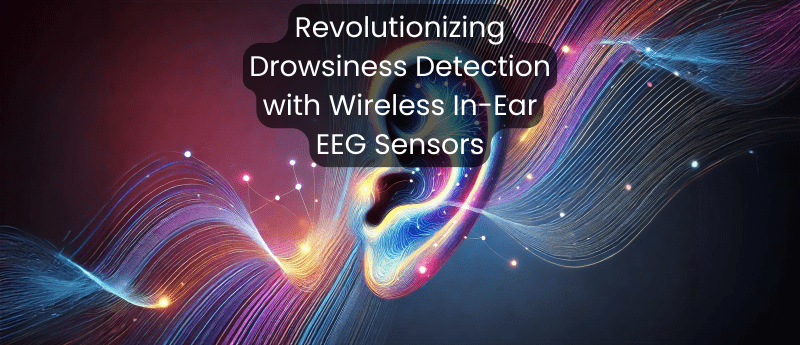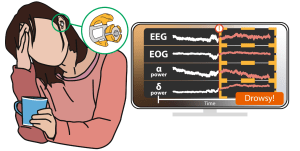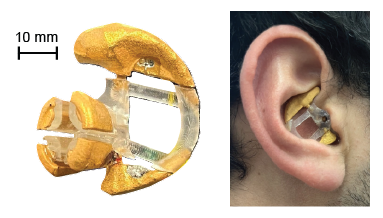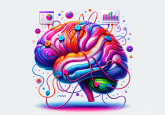Revolutionizing Drowsiness Detection with Wireless In-Ear EEG Sensors

Engineers have created a pioneering AI-driven wearable: earbuds with in-ear EEG sensors that detect drowsiness by monitoring brain activity. The technology merges advanced hardware with machine learning, offering a practical solution to reduce fatigue-related risks in various industries and paving the way for broader health monitoring applications.
Drowsiness poses a serious risk across various sectors, from transportation to industrial work, where the margin for error is slim. As fatigue sets in, the chances of accidents and errors increase dramatically, making it imperative to develop advanced tools for monitoring and mitigating this hidden danger.
Addressing this pressing issue, engineers at the University of California, Berkeley (CA, US), have developed an innovative solution that synergizes advanced hardware with AI: prototype earbuds equipped with in-ear EEG sensors capable of detecting signs of drowsiness by monitoring brain activity.
Marrying Hardware Innovation with AI
The core of this breakthrough lies in the integration of AI-driven machine learning algorithms with cutting-edge wearable technology. These earbuds function similarly to an electroencephalogram (EEG), a medical test that measures electrical activity in the brain. Unlike traditional EEGs that require electrodes affixed to the scalp, this Ear EEG platform embeds electrodes within earbuds to capture brain waves from the ear canal.

Envisioned Ear ExG Wearable. Credit: Ryan Kaveh/UC Berkeley
However, detecting subtle electrical signals from the ear canal presents challenges.
The signals are inherently weaker than those obtained from the scalp. Overcoming this, the research team employed sophisticated AI algorithms to interpret the data accurately.
As detailed in their recent study published in Nature Communications, these algorithms adeptly identify alpha waves—brain activity patterns that escalate when an individual closes their eyes or starts to drift into sleep.
“I was inspired when I bought my first pair of Apple’s AirPods in 2017. I immediately thought, ‘What an amazing platform for neural recording,’” remarked Rikky Muller, senior author of the study and associate professor of electrical engineering and computer sciences at UC Berkeley.
“The fusion of wearable tech with AI opens doors to myriad applications, from classifying drowsiness to diagnosing sleep disorders.”
Overcoming Design and Data Challenges
Creating earbuds that serve as EEG electrodes necessitates ensuring consistent skin contact for reliable data acquisition. Traditional solutions involved using wet electrode gels or custom-molded earpieces tailored for individual users.

A schematic of the Ear EEG (left) and the Ear EEG being worn by a user (right). Credit: Ryan Kaveh/UC Berkeley
Seeking a more universally applicable design, Muller’s team engineered a dry, user-generic model. This design features multiple electrodes arranged in a cantilevered structure, applying gentle pressure to the ear canal, complemented by flexible electronics for comfort. Signals are transmitted via a custom, low-power wireless interface.
Yet, hardware innovation was only half the battle. The real challenge was making sense of the noisy and variable data captured from diverse users. This is where AI played a pivotal role.
“My personal goal was to craft a device usable daily by individuals who’d truly benefit,” said Ryan Kaveh, a UC Berkeley postdoctoral scholar and co-first author of the study. “To achieve this, it had to be reusable, adaptable to various users, and straightforward to manufacture. But equally crucial was developing AI models capable of interpreting the nuanced EEG data effectively.”
Deploying Machine Learning for Accurate Drowsiness Detection
In their experimental setup, nine volunteers donned the earpieces while engaging in monotonous tasks within a dimly lit environment. Periodically, participants rated their drowsiness levels, and their response times were meticulously recorded.
The collected EEG data, rich with temporal and spectral features, was then processed using an array of machine learning algorithms. Models such as Support Vector Machines, logistic regression, and random forests were trained to discern patterns indicative of drowsiness. These algorithms analyzed features like alpha wave activity, eye blinks, and other physiological signals correlated with sleep onset.
“We discovered that even when the signal quality from the earpieces appeared suboptimal, our AI models could still classify the onset of drowsiness with accuracy comparable to more intricate, bulky systems,” Kaveh noted. Remarkably, the earpieces maintained their precision in detecting drowsiness in first-time users, underscoring the AI models’ robustness and generalizability.
This adaptability is crucial, as it implies the system requires minimal to no individual calibration, making it viable for widespread, out-of-the-box deployment.
Broader Implications and Future Directions
Muller, who advanced the Ear EEG with support from the Bakar Fellowship and the Bakar Prize, envisions expansive applications for this technology. Beyond drowsiness detection, the system’s AI capabilities could extend to monitoring heartbeats, eye movements, and jaw clenches, paving the way for comprehensive health monitoring.
“Wireless earbuds are devices we routinely use,” Muller emphasized. “Integrating them with AI-driven health monitoring transforms them into powerful tools without demanding any additional effort from users.”
This study, backed by the Ford University Research Program and a Bakar Spark Award, exemplifies the transformative potential of merging AI with wearable technology. As development continues, such integrations promise to enhance safety, health, and overall quality of life across various sectors.


